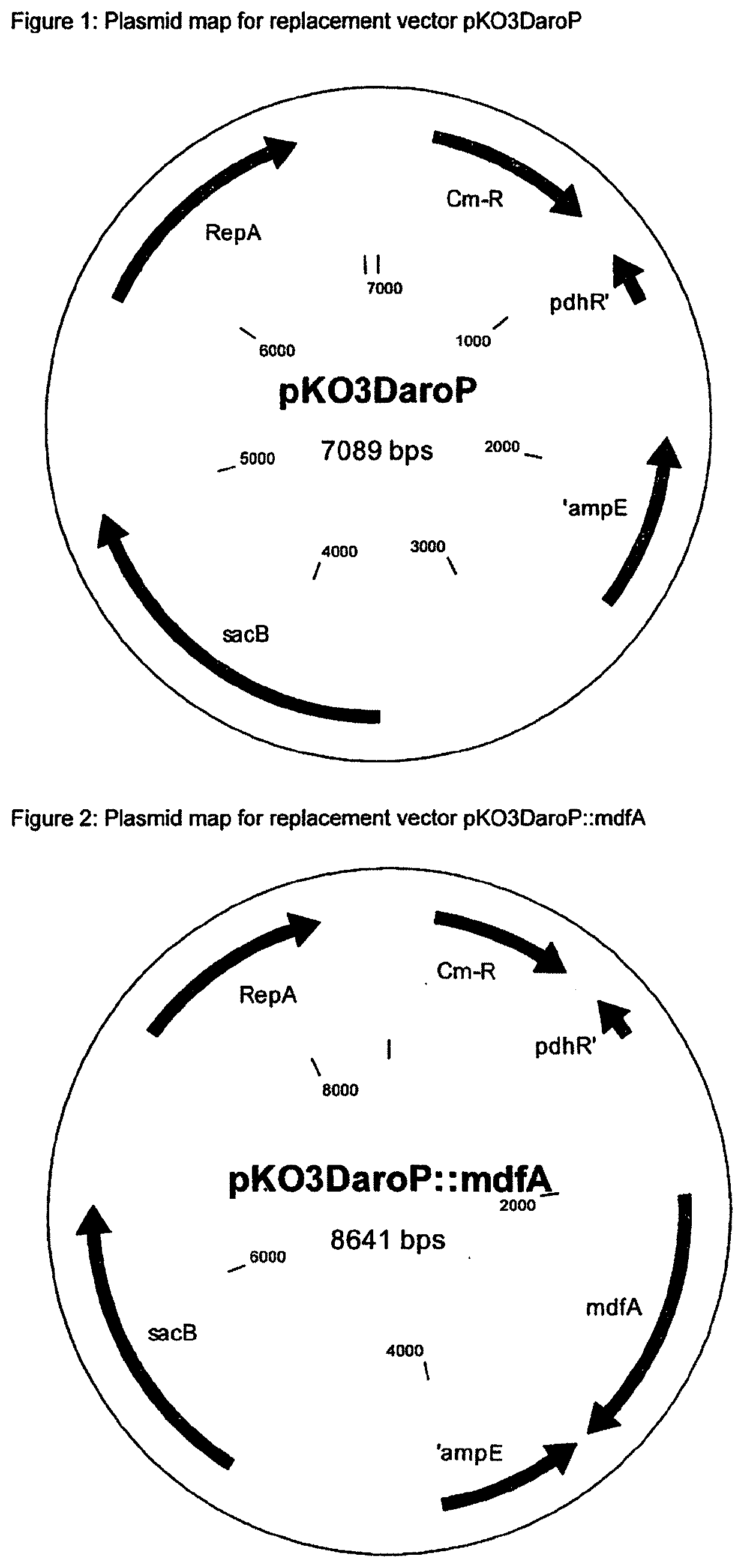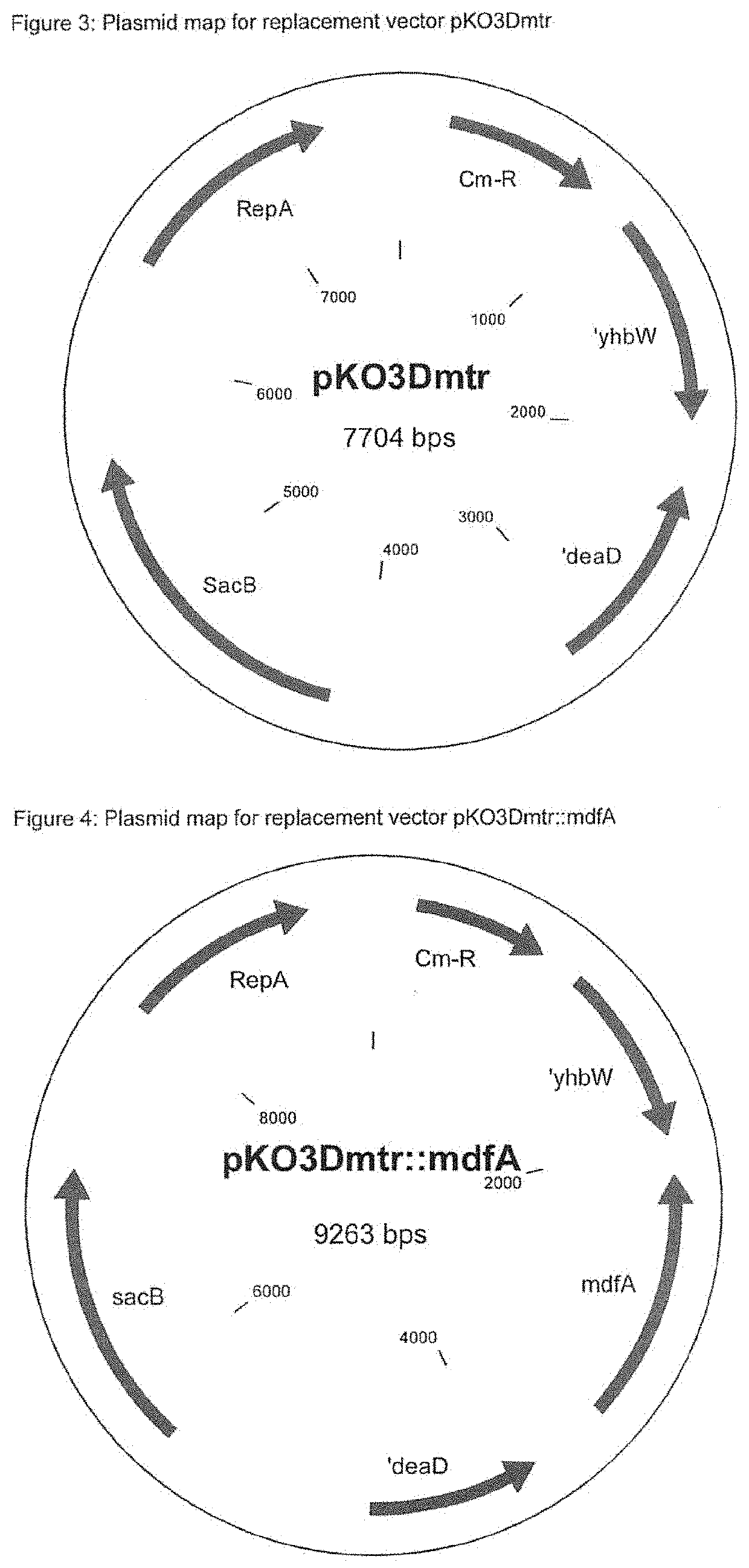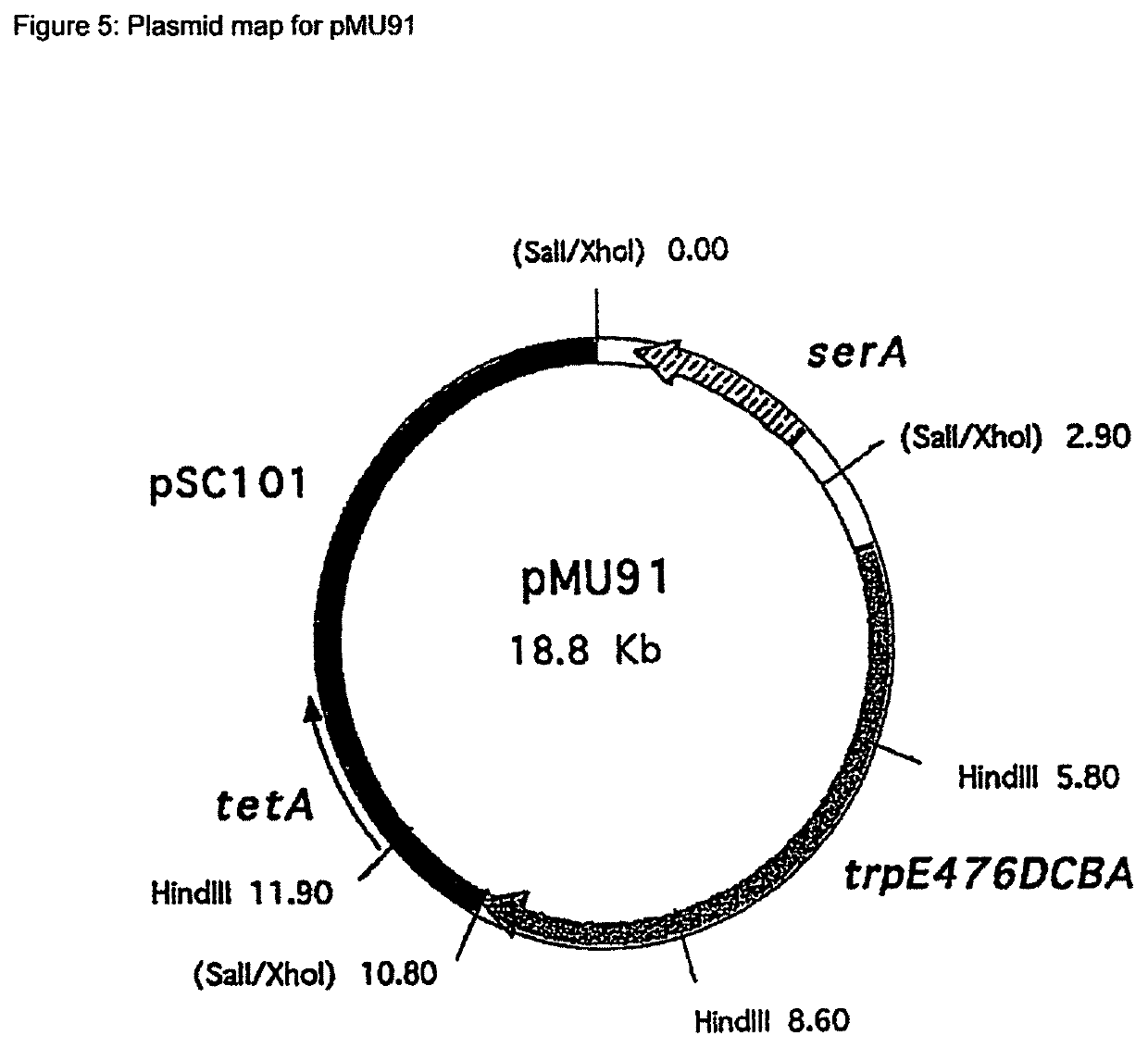Method for producing l-tryptophan using improved strains of the enterobacteriaceae family
- Summary
- Abstract
- Description
- Claims
- Application Information
AI Technical Summary
Benefits of technology
Problems solved by technology
Method used
Image
Examples
example 1
[0124]Construction of the Replacement Vector pKO3DaroP
[0125]The deletion flanks for the deletion of aroP are amplified using the polymerase chain reaction (PCR) and the deletion fragment was produced by overlap PCR. Proceeding from the nucleotide sequence of the aroP gene in E. coli K-12 MG1655 (accession number NC_000913.3, region: 120178-121551, Blattner et al. (Science 277: 1453-1462 (1997)) and the flanking regions, PCR primers are synthesized (Eurofins Genomics GmbH (Ebersberg, Germany)). The primers are designed such that the entire aroP gene is deleted.
[0126]Primer Design and PCR of the Two Flanks
Flank 1aroP-up1SEQ ID NO.: 35′ GATCTGAGCTCTAGACCTGGCGACGAAGCAACAAG 3′ XbalaroP-up6SEQ ID NO.: 45′ GCGTTGGTGTAATCGCGAACCTCGTGCGGTGGTTGTT 3′ Nrul
[0127]The chromosomal E. coli MG1655 DNA used for the PCR is isolated using the QIAGEN DNeasy Blood & Tissue Kit (QIAGEN GmbH, Hilden, Germany) according to the information from the manufacturer. Using the two specif...
example 2
[0147]Construction of the Replacement Vector pKO3Dmtr
[0148]The deletion flanks for the deletion of mtr are amplified using the polymerase chain reaction (PCR) and the deletion fragment was produced by overlap PCR. Proceeding from the nucleotide sequence of the mtr gene in E. coli K-12 MG1655 (accession number NC_000913.3, region: 3304573-3305817, Blattner et al. (Science 277: 1453-1462 (1997)) and the flanking regions, PCR primers are synthesized (Eurofins Genomics GmbH (Ebersberg, Germany)). The primers are designed such that the entire mtr gene is deleted.
[0149]Primer Design and PCR of the Two Flanks
Flank 1SEQ ID NO.: 10mtr-del-Xba-1 5′ TTGAGAACCGCGAGCGTCGTCTG 3′mtr-del-Xba-2SEQ ID NO.: 115′ TCTAGATTCGCGAGGGCTTCTCTCCAGTGAAA 3′ Xbal Nrul
[0150]The chromosomal E. coli MG1655 DNA used for the PCR is isolated using the QIAGEN DNeasy Blood & Tissue Kit (QIAGEN GmbH, Hilden, Germany) according to the information from the manufacturer. Using the two specific primers “mtr-del-Xba-1” a...
example 3
[0170]Construction of the Replacement Vectors pKO3DaroP::mdfA and pKO3Dmtr::mdfA
[0171]3.1 Construction of the Vector pB-mdfA
[0172]The mdfA allele is amplified using the polymerase chain reaction (PCR). Proceeding from the nucleotide sequence of the mdfA gene in E. coli K12 MG1655 (accession number NC_000913.3, region: 883673-884905, Blattner et al. (Science 277: 1453-1462 (1997)), PCR primers are synthesized (Eurofins Genomics GmbH (Ebersberg, Germany)).
[0173]Primer Design and PCR of the mdfA Gene Region
SEQ ID NO.: 15cmr-for: 5′ CGTCGCGATACAGGCAAGTCGTTGAG 3′ NrulSEQ ID NO.: 16cmr-rev: 5′ CCTCGCGACAGATTGACGACCATCAC 3′ Nrul
[0174]The chromosomal E. coli MG1655 DNA used for the PCR is isolated using the QIAGEN DNeasy Blood & Tissue Kit (QIAGEN GmbH, Hilden, Germany) according to the information from the manufacturer. Using the two specific primers “crmr-for” and “cmr-rev”, PCR is carried out under standard PCR conditions (Innis et al.: PCR Protocols. A Guide ...
PUM
| Property | Measurement | Unit |
|---|---|---|
| Fraction | aaaaa | aaaaa |
| Molar density | aaaaa | aaaaa |
| Fraction | aaaaa | aaaaa |
Abstract
Description
Claims
Application Information
 Login to View More
Login to View More - R&D
- Intellectual Property
- Life Sciences
- Materials
- Tech Scout
- Unparalleled Data Quality
- Higher Quality Content
- 60% Fewer Hallucinations
Browse by: Latest US Patents, China's latest patents, Technical Efficacy Thesaurus, Application Domain, Technology Topic, Popular Technical Reports.
© 2025 PatSnap. All rights reserved.Legal|Privacy policy|Modern Slavery Act Transparency Statement|Sitemap|About US| Contact US: help@patsnap.com



